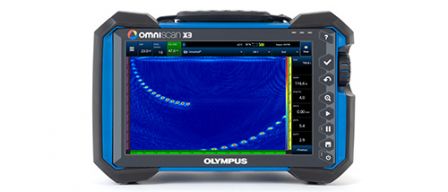Development and application of Phased Array techniques
China Oil Offshore Engineering Company (hereinafter referred to as COOEC) is one of a few general engineering contracting companies in China that use modern testing equipment. COOEC is actively involved in offshore drilling for oil and engages in petrochemical engineering. COOEC also commissions and maintains sources of liquid natural gas (LNG) in the Far East and South East Asia. Given this scope of activity, COOEC is one of the largest engineering, procurement, construction and installation (EPCI) companies in Asia.
In 2002, COOEC introduced the PipeWIZARD, an Automated Ultrasonic Testing (AUT) inspection system in China. During the next 10 years, COOEC has continued to expand their holdings of Olympus testing equipment. Today, they own the largest collection of Olympus equipment in Asia-Pacific (COOEC owns 13 PipeWIZARD systems and 9 OmniScan systems).
COOEC developed the Phased Array inspection technique for monitoring carbon steel pipeline and corrosive resistant alloy (CRA). This AUT inspection technique strictly follows the requirements specified by DNV-OS-F101 (2012). Consequently, COOEC continues to provide high quality QC service to their clients in China and overseas. Specifically, COOEC has demonstrated abundant technical capability, including wall thickness measure of a 4.5 in. sub-sea pipeline and all associated fast water cooling devices. COOEC has also developed accurate sizing methods for monitoring defects in stainless steel pipelines using Phased Array Ultrasonic Testing (PAUT). COOEC has filed for patent coverage in China.
AUT Scanning Process for Carbon Steel Pipeline
COOEC has developed a process to perform AUT using computer-controlled mechanized scanners to move transducers over the surface of a carbon steel pipeline. This AUT process is designed to collect optimized data on a predefined grid within a computerized interface. These scanning techniques on carbon steel pipelines provide data on temperature sensitivity, macro sectioning, Radiographic Testing (RT) and Time-of-Flight Diffraction (TOFD). All aspects of this development process have been fully documented.
Detail description:
- Detection of 98 defective manufactured welds and 445 induced defects
- Performed 1080 AUT scanning tests
- Used SALAMI method to macro section 2200 pipeline slices
- Documented the scanning process with 264 photos
- Issued 1712 documented reports
All of the documented test methods, scanning processes and test data conform to the specific requirements of DNV-OS-F101 (2012), and the acquired AUT system qualification report from DNV-GL (report No.: 2013-4086_Rev01).


AUT Scanning Process for Corrosive Resistant Alloy (CRA) Pipeline
COOEC has also developed a process to perform AUT on all corrosive resistant alloy pipelines. For this entire process, COOEC collected optimized data on a predefined grid within a computerized interface. The scanning techniques provide data on temperature sensitivity, macro sectioning and Radiographic Testing (RT). All aspects of this development process have been fully documented.
Details as follows:
- Detection of 22 defective manufactured welds and 285 induced defects
- Performance of 140 documented scanning tests
- Use of the SALAMI method to macro section 445 slices of the pipeline
- Documented reports with 96 photographs
- Prepared and filed 498 reports
All of the tests methods, scanning processes and test data that COOEC collected, meet with the specific requirements of DNV-OS-F101 (2012), and the acquired CRA system qualification report from DNV-GL (report No.: 2014-4014_Rev02).
Project Application Achievements
The AUT PAUT scanning techniques developed by COOEC have been reviewed and approved by their clients. These approved reports enable COOEC to provide a satisfactory QC service to their clients.
| No. | Project Name | Technique | Material | Standard |
| 1 | LW3-1 deep water pipe-lay project | AUT | CS | DNV-OS-F101 (2005) |
| 2 | CRA pipe-lay project | AUT | CRA | DNV-OS-F101 (2005) |
| 3 | LF7-2 pipe-laying project | AUT | CS | DNV-OS-F101 (2005) |
| 4 | HZ 19-2/3 pipe-laying project | AUT | CS | API 1104 (2005) |
| 5 | PL 19-3 pipe-laying project | PAUT | CS | API 1104 (2005) |
| 6 | LW3-1 Topside-building Project | PAUT | CS | ASME B31.3 344.6.2 |
| 7 | PY 34-1 Project | PAUT | CS/CRA | ASME B31.3 344.6.2 |
| 8 | HZ 25-8 Topside-building Project | PAUT | DSS | ASME B31.3 344.6.2 |
| 9 | En 24-2 Topside-building Project | PAUT | DSS | ASME B31.3 344.6.2 |
| 10 | CX/CX-N Topside-building Project | PAUT | CS | ASME Code Case 181 |
| 11 | BSP Project | PAUT | DSS | ASME B31.3 344.6.2 |
Material Legend: CS----Carbon Steel; CRA----Corrosion Resistance Alloy; SS----Stainless Steel; DSS----Duplex Stainless Steel
COOEC has maintained a high standard, upholding the concept of providing high quality service to their clients. COOEC has perfected existing processes, developed new techniques, realized first class engineering quality and continued to provide high quality products.






